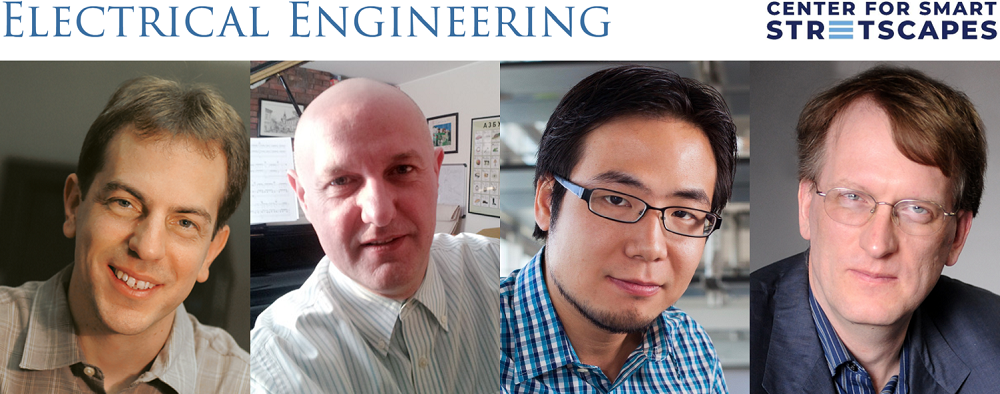Four EE faculty take part in a $26M NSF Engineering Research Center that Focuses on Smart Streetscapes

The National Science Foundation (NSF) awarded a $26 million, five-year grant to a team led by Columbia Engineering, together with Florida Atlantic University, Rutgers University, University of Central Florida, and Lehman College, for a new Gen-4 NSF Engineering Research Center for Smart Streetscapes (CS3). The grant, which is one of the largest NSF research grants to Columbia University's Morningside campus to date, supports high-risk, high-payoff research centers focused on advancing engineered systems technology and education with high-societal impact, will fund the development of streetscape applications to forge livable, safe, and inclusive communities.
Currently, more than 80% of Americans and over half the world’s population live in urban areas. High-density cities are transforming how people live, work, travel, and manage urban infrastructure. With the nation’s urban areas facing challenges that threaten livability, safety, and inclusion, it is streetscapes – neighborhood streets, sidewalks, and public spaces – that are at the center of public and commercial activities, where data can be harnessed for the public good.
Understanding complex streetscapes in real time requires progress in fundamental engineering knowledge and enables exciting opportunities for deploying public interest technology: A smart streetscape of the future can instantly sense human behavior and guide disabled pedestrians, collect refuse, control pests, amplify emergency services, and protect people against environmental and health threats. It can address unmet needs in road and public safety, traffic efficiency, assistive technologies, outdoor work, and hyper-local environmental sensing. The CS3 project is focused on doing all that with the active, ongoing collaboration of its many diverse stakeholders.
“With this grant, we have an opportunity to transform this nation’s streetscapes with smart technologies that address critical safety, equity, privacy, and security concerns,” said Columbia President Lee C. Bollinger. “By helping cities better meet the needs of local communities, this project exemplifies what I call the Fourth Purpose of the University—a vision that embraces the capacity of educational institutions to advance human welfare through academic work and with outside partners.”
The center is taking a new approach to engineering research on smart cities: the researchers are working closely with a diverse cohort of more than 80 non-academic community stakeholders – industry partners, community organizations, municipalities, and K-12 schools – both as collaborative co-producers of knowledge and as auditors of technology research and development. CS3 researchers and partners will collaboratively shape research objectives and application outcomes and support workforce development, internships, industry collaborations, entrepreneurship, student opportunities from middle school through postdoctoral programs, visiting faculty, and community engagement.
“Through a multitude of strong public and private partnerships, we now have the opportunity to realize a vision for the future of smart streetscapes and the true smart city,” said Columbia Engineering Dean and Electrical Engineering Professor Shih-Fu Chang. "CS3 is a natural and powerful expansion of Columbia Engineering’s commitment to engineering for humanity. It will advance fundamental knowledge in key areas in civil and urban systems engineering–from visual analytics and sensor fusion to computer privacy and security– mobilizing the emerging discipline of smart cities.”
“This NSF Engineering Research Center is the perfect vehicle to make an impact right now,” said CS3 Director and Principal Investigator Andrew Smyth, Robert A.W. and Christine S. Carleton Professor of Civil Engineering and Engineering Mechanics. “This is a federally funded academia-led center with real working partnerships with community organizations, local, state, and federal government entities, as well as small, medium, and large industry stakeholders, all working together to develop technologies that are actually beneficial to a broad range of stakeholders for prioritizing the social good.”

The center’s underlying technologies will integrate advances in wireless/optical communications, edge/cloud computing, situational awareness, and privacy and security, while balancing public sphere data collection requirements with community-defined benefits. With its extensive network of partners, CS3 will unite diverse research communities through a convergent research model that delivers innovations across five engineering and scientific areas:
- “Wi-Edge” – the integration of high-speed wireless-optical networking, high-performance edge-cloud computing, and software-defined radios and networking
- Situational Awareness – fine-scale, real-time observation, modeling, and forecasting of human behavior over variable time horizons at streetscape scales
- Security, Privacy, and Fairness – addressing socio-technical barriers of privacy and security within locally intelligent streetscapes, yielding a software pipeline for streetscape applications that gives community-configurable guarantees of privacy, fairness, and transparency
- Public Interest Technology – understanding how CS3 technologies, applications, and security/privacy policies impact the social landscape and promote regional economic development
- Streetscape Applications – incorporating the distinct ways in which individual communities read, interpret, and respond to local intelligence within the design process in order to optimize community-specific benefits.
Columbia Electrical Engineering faculty will contribute several of these thrusts. Moreover, the center will build on the COSMOS testbed and summer program for teachers designed by Electrical Engineering faculty and their collaborators.
Particularly, Electrical Engineering Professor and Vice Chair Gil Zussman leads CS3 Thrust 1: Wi-Edge. Wi-Edge aims to combine beyond-5G software-defined radios (SDRs), including sub-7GHz and mmWave, in a cloud-based radio access network (CRAN). Zussman and his students will study areas such as mmWave communication and sensing and integration of optical, wireless, and edge-cloud networks.
Electrical Engineering Associate Professor Xiaofan (Fred) Jiang group will investigate embedded AI for real-time spatial temporal sensing. Along with his students, he will explore intelligent acoustic systems for improving pedestrian and construction worker safety, and providing situational awareness as a public service.
Electrical Engineering Professor of Professional Practice Zoran Kostic group will focus on using high bandwidth sensors such as cameras, together with AI-enabled edge-cloud servers, to provide high accuracy in detection and tracking of objects in smart intersections.
Computer Science and Electrical Engineering Professor Henning Schulzrinne will focus on technologies required for Wi-Edge, including spectrum sharing, streaming for machine-to-machine applications at the edge, and support for the Internet of Things. In addition Schulzrinne’s group will focus on privacy and security aspects at the edge.
Professors Jiang, Kostic, Schulzrinne, and Zussman are all members of the Columbia Data Science Institute (DSI). Jiang serves as co-Chair of the DSI Smart Cities Center, together with Professor Andrew Smyth.
The NSF PAWR COSMOS testbed in Harlem, where Electrical Engineering faculty Kostic, Krishnaswamy, Schulzrinne, and Zussman and CUIT CTO Alan Crosswell are major contributors, will serve as one of the main CS3 testbeds.Using COSMOS will allow CS3 researchers to advance wireless technologies and enable them to develop and test new classes of applications in smart streetscapes.
Building on the NSF COSMOS-NewLAW Research Experience for Teachers (RET) program co-led by Electrical Engineering faculty Kostic, Krishnaswamy, and Zussman, the RET program in CS3 seeks to train teachers from New York City to master the most advanced techniques in wireless technology, and design web-based lab experiments that illustrate the theory and practice of wireless networking. Participating teachers will be able to incorporate science, math, and computer science lab experiments developed through this program within their classrooms, giving students hands-on experience with the next wave of mobile technology.
“For decades, NSF Engineering Research Centers have transformed technologies and fostered innovations in the United States through bold research, collaborative partnerships, and a deep commitment to inclusion and broadening participation," said NSF Director Dr. Sethuraman Panchanathan. “The new NSF centers will continue the legacy of impacts that improve lives across the Nation.”
“One strength of NSF Engineering Research Centers is their ability to bring interdisciplinary academic teams together in convergent research to identify novel approaches to thorny societal challenges," said Dr. Susan Margulies, NSF Assistant Director for Engineering. “With their unique testbeds and industry partners, the centers innovate and translate solutions that are effective and sustainable.”
(This article is based on the press release by Columbia Engineering.)